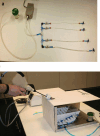Feeling of pulsations in artificial arteries with a real time haptic feedback laparoscopic grasper: a validation study
- PMID: 38858248
- PMCID: PMC11289014
- DOI: 10.1007/s00464-024-10877-w
Feeling of pulsations in artificial arteries with a real time haptic feedback laparoscopic grasper: a validation study
Abstract
Introduction: Despite the advancements in technology and organized training for surgeons in laparoscopic surgery, the persistent challenge of not being able to feel the resistance and characteristics of the tissue, including pulsations, remains unmet. A recently developed grasper (Optigrip®) with real time haptic feedback, based on photonic technology, aims to address this issue by restoring the tactile sensation for surgeons. The key question is whether pulsations can be detected and at what minimal size level they become clinical significant.
Methods: To simulate arterial conditions during laparoscopic procedures, four different silicone tubes were created, representing the most prevalent arteries. These tubes were connected to a validated pressure system, generating a natural pulse ranging between 80 and 120 mm Hg. One control tube without pressure was added. The surgeons had to grasp these tubes blindly with the conventional grasper or the haptic feedback grasper in a randomized order. They then indicated whether they felt the pressure or not and the percentage of correct answers was calculated.
Results: The haptic grasper successfully detected 96% of all pulsations, while the conventional grasper could only detect 6%. When considering the size of the arteries, the Optigrip® identified pulsations in 100% the 4 and 5 mm arteries and 92% of the smallest arteries. The conventional grasper was only able to feel the smallest arteries in 8%. These differences were highly significant (p < 0.0001).
Conclusion: This study demonstrated that the newly developed haptic feedback grasper enables detection of arterial pulsations during laparoscopy, filling an important absence in tactile perception within laparoscopic surgery.
Keywords: Arterial pulsations; Laparoscopic surgery; Realtime haptic feedback.
© 2024. The Author(s).
Conflict of interest statement
Dr. Michel P. H. Vleugels is the inventor and patent holder of this technology. Dr. A. Masie Rahimi has no conflict of interest or financial ties to disclose.
Figures







Similar articles
-
Performance of a Haptic Feedback Grasper in Laparoscopic Surgery: A Randomized Pilot Comparison With Conventional Graspers in a Porcine Model.Surg Innov. 2019 Oct;26(5):573-580. doi: 10.1177/1553350619848551. Epub 2019 Jun 4. Surg Innov. 2019. PMID: 31161876 Clinical Trial.
-
Design and Evaluation of a Balanced Compliant Laparoscopic Grasper.IEEE J Transl Eng Health Med. 2023 Jul 3;11:451-459. doi: 10.1109/JTEHM.2023.3291925. eCollection 2023. IEEE J Transl Eng Health Med. 2023. PMID: 37817822 Free PMC article.
-
Ergonomics of laparoscopic graspers and the importance of haptic feedback: the surgeons' perspective.Gynecol Surg. 2016;13(4):379-384. doi: 10.1007/s10397-016-0959-z. Epub 2016 Jun 4. Gynecol Surg. 2016. PMID: 28003799 Free PMC article.
-
A perspective on the role and utility of haptic feedback in laparoscopic skills training.Crit Rev Biomed Eng. 2014;42(3-4):293-318. doi: 10.1615/critrevbiomedeng.2014011701. Crit Rev Biomed Eng. 2014. PMID: 25597241 Review.
-
Review on aspects of artificial tactile feedback in laparoscopic surgery.Med Eng Phys. 2009 Oct;31(8):887-98. doi: 10.1016/j.medengphy.2009.06.003. Med Eng Phys. 2009. PMID: 19595620 Review.
References
-
- Pizzol D, Trott M, Grabovac I, Antunes M, Colangelo AC, Ippoliti S, Ilie CP, Carrie A, Veronese N, Smith L (2021) Laparoscopy in low-income countries: 10-year experience and systematic literature review. Int J Environ Res Public Health. 10.3390/ijerph18115796 10.3390/ijerph18115796 - DOI - PMC - PubMed
Publication types
MeSH terms
LinkOut - more resources
Full Text Sources

